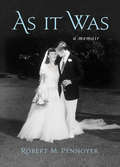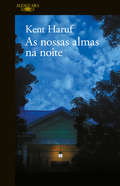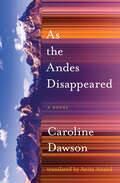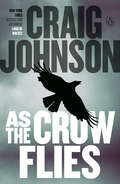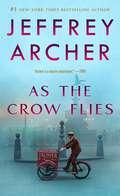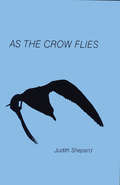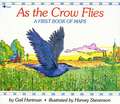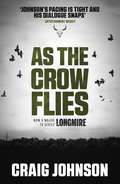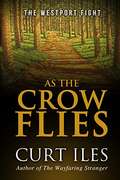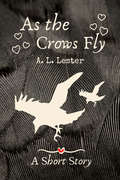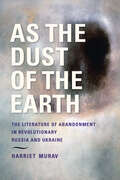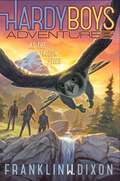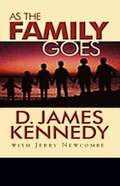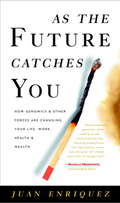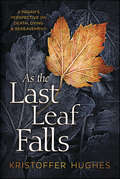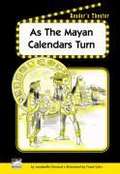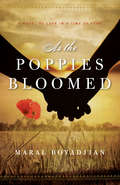- Table View
- List View
As it Was
by Robert PennoyerAs It Was begins in an era of unprecedented wealth and privilege for some and great misery and poverty for others, - one that Mark Twain lampooned as the "Gilded Age," and ends, coming in effect full circle, in our own era of the One Per Cent, as the income chasm in America reopens. What divides these periods, and is so impressively portrayed here, is the rise of American Progressivism led by the two Roosevelts. <P><P> Most importantly, this book is itself a demonstration of the values that boosted America on its path to greatness and for which no finer exemplar could be found than its author. It bespeaks a belief in democracy that is passionate and unshakable, and builds on a deep appreciation of the institutions that enable it. The spirit that flows through these pages may be modest, but it is also filled with an irrepressible optimism and a faith in simple values that are both uplifting and marvelously contagious. As It Was is a lesson in a life well lived, and a tonic for dark and troubled times. " -- Scott Horton, author ofLords of Secrecy: The National Security Elite and America's Stealth Warfare (2015), contributing editor,Harper's Magazine.
As nossas almas na noite
by Kent HarufEm Holt, uma pequena cidade do Colorado, Addie Moore faz uma visita inesperada a Louis Waters, seu vizinho. Viúvos, às portas da velhice, ambos tentam acomodar-se a uma vida diferente nas casas agora vazias. O mais difícil de suportar são as longas noites solitárias. <p><p> Addie não está disposta a aceitar uma vida tão cinzenta e, então, propõe a Louis que ele passe a dormir em sua casa, para ambos terem alguém com quem conversar à noite. Perante tão inesperado convite, Louis não tem opção senão aceitar. Pouco a pouco, Louis e Addie vão despindo a alma nessas noites, revivendo os sonhos da juventude, as doçuras e amarguras do casamento, as esperanças do passado, os medos do presente. Noite após noite, os dois estão cada vez mais certos de querer passar juntos o resto dos seus dias. <p><p> Neste aclamado romance, que terminou poucos dias antes de morrer, Kent Haruf retrata com ternura e delicadeza as segundas oportunidades e a emoção de redescobrir os pequenos prazeres da vida, que pode ganhar um novo sentido mesmo quando parece ser tarde demais.
As on a Darkling Plain
by Ben BovaMAN IN THE MIDDLE It had been over fifty years since Sydney Lee began his quest for the Others--the alien creatures who had succeeded in destroying Earth's first great civilization, and now threatened humankind again. After fifty years the Others remained the masters--unknowable, unreachable, moving to complete their design of destruction. But on Earth things had changed. While Sydney Lee had remained frozen and unaging in his flight through space, his most bitter rival had climbed steadily to the peak of power. Sydney Lee was faced with nameless danger before him, and the threat of deadly treachery behind, as he made his desperate gamble with the unknown....
As the Andes Disappeared (Literature in Translation Series)
by Anita Anand Caroline DawsonCaroline is seven years old when her family flees Pinochet’s regime, leaving Chile for Montreal on Christmas Eve, 1986. She fears Santa won’t find them on the plane but wakes to find a new doll at her side, her mother preserving the holiday even amidst persecution and turmoil. This symbol of care is repeated throughout their relocation as her parents work tirelessly to provide the family with a new vision of the future.Once in Canada, Caroline accompanies her parents as they clean banks at night. She experiences racist microaggressions at school, discovers Québécois popular culture, and explores her love of reading and writing in French. Slowly, the Andean peaks disappear from Caroline’s drawings and a fracture between her parents’ identity and her own begins to grow.This expansive coming-of-age autobiographical novel probes the plurality of identity, elucidating the interwoven complexities of immigrating to a new country. As the Andes Disappeared tenderly reflects the journey of millions and is a beautiful ode to family commitment and the importance of home—however layered that may be.
As the Crow Flies
by Craig JohnsonOn the heels of A&E's blockbuster show Longmire--the latest New York Times bestseller in a "a top-notch tale of complex emotions and misguided treachery" (USA Today) The recent A&E premiere of Longmire--a television series based on Craig Johnson's New York Times bestselling Longmire Mystery Series--was the highest rated scripted drama in the network's history and consistently held its viewers throughout the season. Its success has readers stampeding to the bookstore, making As the Crow Flies Johnson's biggest hardcover success. In his eighth adventure, Walt Longmire doesn't have time for criminals. His daughter is getting married in two weeks and the wedding locale arrangements have just gone up in smoke signals. He needs to find a new site for the nuptials--fast. Unfortunately, his expedition to the Cheyenne Reservation is derailed by a grisly death. It's not Walt's turf, but he's coerced into the investigation by Lolo Long, the beautiful new tribal police chief.
As the Crow Flies
by Craig JohnsonWalt gets shanghaied into a murder investigation on the Reservation in this New York Times bestseller from the author of The Cold Dish and Hell Is Empty, the most recent novel in the Walt Longmire Mystery Series, the basis for LONGMIRE, the hit A&E original drama seriesFans of Robert B. Parker will love this eighth adventure in the New York Times bestselling and award-winning Walt Longmire mystery series. Wyoming Sheriff Walt Longmire has a more important matter on his mind than cowboys and criminals. His daughter, Cady, is getting married to the brother of his undersheriff, Victoria Moretti. Walt and old friend Henry Standing Bear are the de facto wedding planners and fear Cady's wrath when the wedding locale arrangements go up in smoke two weeks before the big event.The pair set out to find a new site for the nuptials on the Cheyenne Reservation, but their scouting expedition ends in horror as they witness a young Crow woman plummeting from Painted Warrior's majestic cliffs. It's not Walt's turf, but the newly appointed tribal police chief and Iraqi war veteran, the beautiful Lolo Long, shanghais him into helping with the investigation. Walt is stretched thin as he mentors Lolo, attempts to catch the bad guys, and performs the role of father of the bride.
As the Crow Flies
by Jeffrey ArcherThe story of a poor barrow boy, born in 1900, who rises to become the founder of Britain's first and most prestigious department store and a member of the peerage.
As the Crow Flies
by Jeffrey ArcherEncompassing three continents and spanning over sixty years, bestselling author Jeffrey Archer's As the Crow Flies brings to life a magnificent tale of one man's rise from rags to riches set against the backdrop of a changing century. Growing up in the slums of East End London, Charlie Trumper dreams of someday running his grandfather's fruit and vegetable barrow. That day comes suddenly when his grandfather dies leaving him the floundering business. With the help of Becky Salmon, an enterprising young woman, Charlie sets out to make a name for himself as "The Honest Trader". But the brutal onset of World War I takes Charlie far from home and into the path of a dangerous enemy whose legacy of evil follows Charlie and his family for generations.
As the Crow Flies
by Judith ShepardA collection of poems by Judith Shepard, co-publisher at The Permanent Press.
As the Crow Flies: A First Book of Maps
by Gail Hartman Harvey StevensonMaps -- they help you get where you want to go. People use road maps to find their way. These maps show miles of highways that point out the right direction. But what about the crow? What kind of map does he use? Or the eagle, the rabbit, the horse, and the sea gull? What's on their maps?
As the Crow Flies: A Longmire Mystery
by Craig JohnsonThe eighth novel from the New York Times bestselling author of the Longmire mysteries, the basis for the Netflix original series LONGMIRE Embarking on his eighth adventure, Wyoming Sheriff Walt Longmire doesn't have time for cowboys and criminals. His daughter, Cady, is getting married in two weeks, and the wedding locale arrangements have just gone up in smoke signals. Fearing Cady's wrath, Walt and his old friend Henry Standing Bear set out for the Cheyenne Reservation to find a new site for the nuptials. But their expedition ends in horror as they witness a young Crow woman plummeting from Painted Warrior's majestic cliffs. Is it a suicide, or something more sinister? It's not Walt's turf, but he's coerced into the investigation by Lolo Long, the beautiful new tribal police chief.Craig Johnson's The Highwayman is now available from Viking. An Obvious Fact will be available in September 2016.From the Trade Paperback edition.
As the Crow Flies: An exciting episode in the best-selling, award-winning series - now a hit Netflix show! (A Walt Longmire Mystery #8)
by Craig JohnsonThe eighth book in the New York Times bestselling Longmire series, featuring Sheriff Walt Longmire.Sheriff Walt Longmire's daughter, Cady, is getting married. Walt and old friend Henry Standing Bear are the de facto wedding planners and fear Cady's wrath when the wedding locale arrangements go up in smoke two weeks before the big event.The pair set out to find a new site for the nuptials on the Cheyenne Reservation, but their scouting expedition ends in horror as they witness a young Crow woman plummeting from Painted Warrior's majestic cliffs. It's not Walt's turf, but the newly appointed tribal police chief and Iraqi war veteran, the beautiful Lolo Long, shanghais him into helping with the investigation . . .
As the Crow Flies: The Westport Flight (Westport Trilogy #3)
by Curt Iles“My name is Missouri Cotton and I was born into a family of thieves. All I want in life is to escape, but I’m only fifteen and have no idea how." <P><P>From Missouri Cotton's opening words, it's evident that she is no ordinary girl and her story, as told in As the Crow Flies, is a unique story. <P><P>When Missouri’s gypsy family’s race from the law takes them into Louisiana’s “No Man’s Land” she’s thrust into the middle of an explosive feud between the mysterious Redbones—a mixed Indian group—and encroaching white settlers. <P><P>Missouri finds a slice of refuge with Joe and Eliza Moore, the owners of a frontier store, then finds her heart slipping into the hands of their son, Dan. <P><P>But then, the Westport fight of December 1881 erupts, forcing her family to flee, and requiring Missouri to make a choice that will change the fate of everyone she holds dear. <P><P>As the Crow Flies, by Louisiana author Curt Iles, is the final installment in the critically acclaimed Westport Trilogy. Written in the warm storytelling style embraced by his readers, As the Crow Flies is a story of resilience, hope, and redemption. Much more at www.creekbankstories.com.
As the Crows Fly
by A. L. LesterPaul Webster has come out the army after a twenty-two year stretch with a trick hip and no idea what to do with his life. He takes a few weeks walking along the Welsh coast to get his head on straight.Kevin Davies is a veterinary nurse and an artist. He's getting lonelier and lonelier in his cottage on the edge of the sea, kept company by his cats and a friendly flock of crows.What happens when the two men hunker down together to wait out a wild March gale?
As the Devil Dares (Capturing the Carlisles #3)
by Anna HarringtonWhen playing a game of wits, never ever go up against the woman they call the Hellion . . . LOVE IS A BATTLEFIELD...Whether it's business or pleasure, Lord Robert Carlisle never backs down from a dare. But finding a husband for scandalous Mariah Winslow? It's one challenge he instantly regrets accepting. Even with all his connections---and rakish charms---Robert will have to use every trick in the book to marry off a woman with no dowry and no sense of decorum...no matter how stunningly beautiful she is.Mariah Winslow has no intention of being a pawn in Lord Robert's game. She knows he agreed to play matchmaker only to secure a partnership in her father's shipping company, a partnership that's rightfully hers. For now, though, she'll dress for the elegant balls he throws and dance with the eligible bachelors he chooses. But she won't be outwitted by the devil himself---no matter how tempting and irresistible she finds him."With its strong feminist bent and lively battle of wills, Harrington delivers what readers crave: a smart, fun read." -RT Book ReviewsCapturing the CarlislesIf the Duke DemandsWhen the Scoundrel SinsAs the Devil Dares
As the Dust of the Earth: The Literature of Abandonment in Revolutionary Russia and Ukraine (Jews in Eastern Europe)
by Harriet MuravAn estimated forty thousand Jews were murdered during the Russian Civil War between 1918 and 1922. As the Dust of the Earth examines the Yiddish and Russian literary response to the violence (pogroms) and the relief effort, exploring both the poetry of catastrophe and the documentation of catastrophe and care.Brilliantly weaving together narrative fiction, poetry, memoirs, newspaper articles, and documentary, Harriet Murav argues that poets and pogrom investigators were doing more than recording the facts of violence and expressing emotions in response to it. They were interrogating what was taking place through a central concept familiar from their everyday lifeworld—hefker, or abandonment. Hefker shaped the documentation of catastrophe by Jewish investigators at pogrom sites impossibly tasked with producing comprehensive reports of chaos. Hefker also became a framework for Yiddish writers to think through such incomprehensible violence by creating new forms of poetry. Focusing less on the perpetrators and more on the responses to the pogroms, As the Dust of the Earth offers a fuller understanding of the seismic effects of such organized violence and a moving testimony to the resilience of survivors to process and cope with catastrophe.
As the Earth Turns
by Gladys H. CarrollIn the 1920's when farming as a means to make a living is becoming less a desirable thing to do, Mark Shaw and his daughter Jen still enjoy the old familiar ways while the rest of their family members yearn for different lives.
As the Falcon Flies (Hardy Boys Adventures #24)
by Franklin W. DixonFrank and Joe circle a new case in the wilds of Alaska in the twenty-fourth book in the thrilling Hardy Boys Adventures series.Frank and Joe Hardy are excited when their parents&’ friends, the Adenshaws, invite them to come visit their home in Alaska. The brothers will have the perfect guide to explore the beautiful landscape the area is known for—their hosts&’ daughter, Kate. During the visit, Kate introduces the Hardys to her beloved peregrine falcon. There&’s a major falconry competition coming up in the United Arab Emirates, and even though Kate can&’t compete, she—like so many others in the falconry world—is eagerly looking forward to the event, which has millions riding on it. One California falconer even offered to buy Kate&’s falcon so he could enter it in the contest. When Kate&’s peregrine goes missing, it looks like the Californian or someone else may have turned criminal in their ruthless desire to win. Kate is devastated, and the Hardy boys have to figure out if her falcon could have flown off…or if it was stolen. Frank and Joe may not know much about birds of prey, but they do know how to solve a mystery. But can they soar to success?
As the Family Goes
by D. James Kennedy Jerry NewcombeCHARLES AND DORIS HAD BEEN MARRIED FOR ABOUT ten years, and for them it seemed like ten years too long. When Charles came home, he would slip in the back door, and his wife would be working in the kitchen. She was always surprised to see him, and would say, "Oh, are you home already?" He said it always sounded like what she really meant was, "Don't tell me you're home already." And he always felt as though he'd done something wrong just by coming home.Then he would go and greet his children, but it always seemed that he stepped between them and the TV set at the wrong moment. The only one who seemed happy to see him was his little dog, Susie. So he would pick up the dog and go outside and pet her. Charles felt like stomping his feet and saying, "Doesn't anybody care? Isn't anybody glad to see me?" But he was a gentleman, so he didn't stomp his feet. He just let these moments pass. But the resentment grew.
As the Future Catches You
by Juan EnriquezYou will never look at the world in the same way after reading As the Future Catches You. Juan Enriquez puts you face to face with a series of unprecedented political, ethical, economic, and financial issues, dramatically demonstrating the cascading impact of the genetic, digital, and knowledge revolutions on your life. Genetics will be the dominant language of this century. Those who can "speak it" will acquire direct and deliberate control over all forms of life. But most countries and individuals remain illiterate in what is rapidly becoming the greatest single driver of the global economy. Wealth will be more concentrated and those with knowledge to sell-both countries and individuals-will be the winners. Consider what will happen when:* Your genetic code can be digitally imprinted on an ID card and your insurance company and employer see that you are genetically disposed to, say, heart disease.* Pharmaceutical products are developed so that you can eat genetically modified broccoli to protect yourself from cancer.* Cloning will be as common as in vitro fertilization and scientists can influence the genetic design not only of other species but of your own children.* Creating wealth no longer requires many hands. Lone individuals are giving birth to entire new industries that rapidly become bigger than the economies of most countries on earth, but create very few jobs.As the Future Catches You resembles no other book. A typical page may contain just a few dozen words. But each seemingly discrete fact is like a chip in an intellectual mosaic that reveals its meaning and beauty only as you step back and see the big picture. Juan Enriquez is like the best teacher you ever had, one who helps you to see something in a new light and makes you say, "Now I get it!" Juan Enriquez's main point is that technology is not kind, it does not say "please," but slams into existing systems and destroys them while creating new ones. Countries and individuals can either surf new and powerful waves of change-or get crushed trying to stop them.The future is catching us all. Let it catch you with your eyes wide open.From the Hardcover edition.
As the Last Leaf Falls: A Pagan's Perspective on Death, Dying & Bereavement
by Kristoffer HughesMove Beyond the Fear of Death and Integrate Its Powerful EnergyAs the Last Leaf Falls is a guide to death and the mysterious world beyond. The rituals, meditations, and exercises are designed to bring you on a journey of discovery through the most profound of all human transitions. Filled with insight and practical guidance, this book shows you how to honor family and friends in spirit and discover the life-affirming aspects of every state of existence.Join renowned Druid priest Kristoffer Hughes as he explores the three Celtic realms of existence—the realm of necessity, the realm of spirit, and the realm of infinity—and illuminates the reality of spiritual continuation. Challenging many status quo beliefs about the afterlife, this illuminating volume supports the important work of confronting death and absorbing its meaning into the core of your spirit.(This book was previously published as The Journey Into Spirit.)
As the Mayan Calendars Turn
by Jeffrey Fuerst Annabelle Howard Frank SofoPerform this script about an ancient Maya love story.
As the Night Ends
by Audrey HowardDriven by her idealism and courage, Alex Goodwin will make any sacrifice to win votes for women. Her despairing family, unable to rescue her from yet another dangerous prison sentence, is overjoyed when Patrick O'Leary comes into her life. A hard-working young surgeon, Patrick is as idealistic as Alex and loves her with all his heart. Then they are separated - first by a quarrel, then by the terrible war which engulfs their world, and finally, after a miraculous reunion, by a tragedy that seems to make it impossible for either of them ever to love again ...
As the Night Ends
by Audrey HowardDriven by her idealism and courage, Alex Goodwin will make any sacrifice to win votes for women. Her despairing family, unable to rescue her from yet another dangerous prison sentence, is overjoyed when Patrick O'Leary comes into her life. A hard-working young surgeon, Patrick is as idealistic as Alex and loves her with all his heart. Then they are separated - first by a quarrel, then by the terrible war which engulfs their world, and finally, after a miraculous reunion, by a tragedy that seems to make it impossible for either of them ever to love again ...
As the Poppies Bloomed: A Novel of Love in a Time of Fear
by Maral BoyadjianDouble Bronze Winner, 2015 Foreword INDIEFAB Book for the Year AwardsFinalist, Best New Fiction Category, 10th Annual National Indie Excellence AwardsFinalist, Best New Fiction Category, 2015 USA Best Book AwardsHonorable Mention, Mainstream Literary Fiction, 23rd Annual Writer's Digest Book AwardsIt is 1913 and late summer in the Ottoman Empire. The sun rises, full and golden, atop a lush, centuries-old village tucked into the highlands where the blood-red poppies bloom. Outside the village leader's home, the sound of voices carries past the grapevines to the lane where Anno, his youngest daughter, slips out unseen.She heads to a secret meeting place. She forgets that enemies surround her village. She forgets that her father meets each day with trepidation. She knows only the love she has for Daron, who waits for her as she hastens to him, once again breaking the ancient rules of courtship.Anno and Daron wish for nothing more than marriage and a better day alongside their neighbors, but neither is prepared for the dark, dangerous secret that Daron's father keeps or the upheaval that will soon envelop their village, their land, and their hearts.
